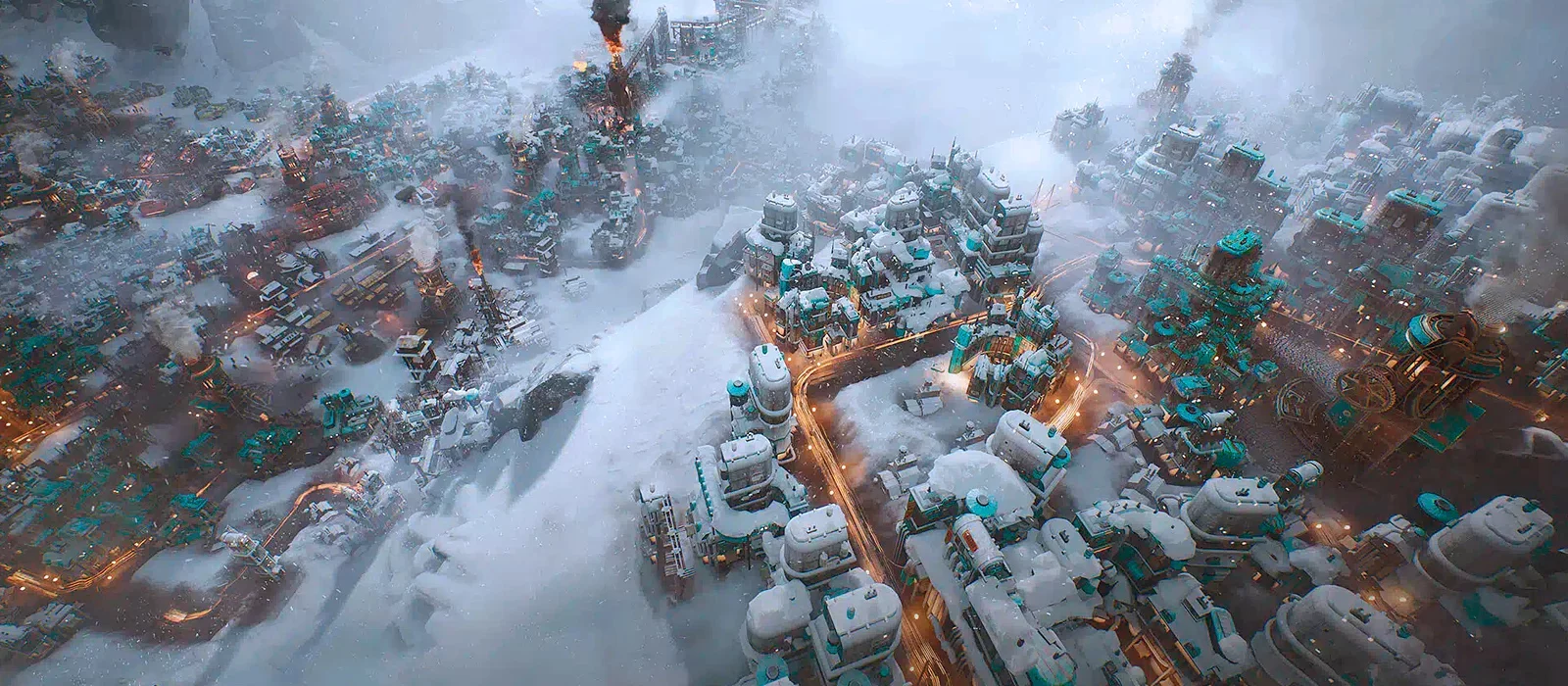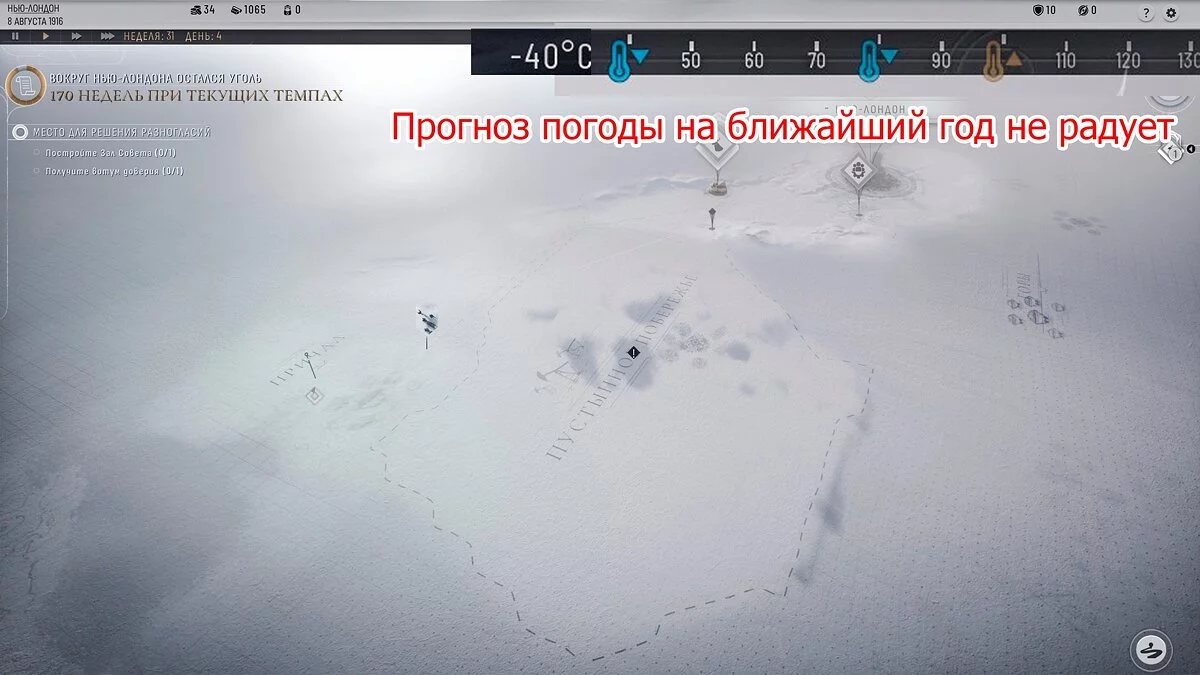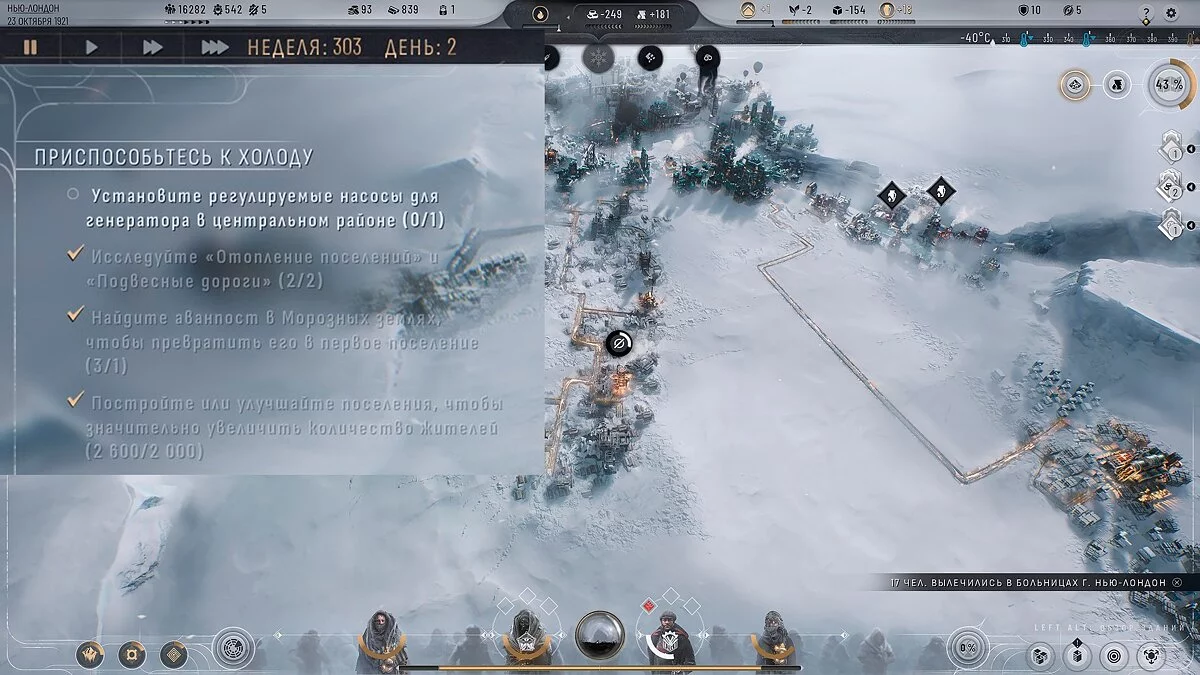How to Insulate the City and Survive the First Storm in Frostpunk 2

A brutal blizzard and a drop in temperature to -100 °C are an inevitable part of the gameplay in Frostpunk 2. It's not just about the harshness of the Frost Lands' world but also the designers' intent. The main storyline for the New London scenario includes a script that automatically triggers the storm, giving you not much time to prepare. How not to trigger the storm prematurely and manage to accumulate resources? We explain in this guide!
You Trigger the Storm Yourself
It's important to understand that all actions related to city development and completing key story tasks will ultimately lead to triggering the storm. This moment is predetermined by the game's scripts and built into its mechanics. The balance is adjusted accordingly — you won't be able to heat the city solely with coal for long, and there just isn't enough coal in the Frost Lands. Moreover, the map is initially half-closed by the threat level. Oil is indispensable.
The game dynamically adjusts the temperature and the timing of its decrease (sometimes increase). Even if the situation seems stable now, the game can drop the temperature to -40° or even -50°, and... you're no longer stockpiling fuel but spending it at an unprecedented rate. Thus, the game forces you to upgrade the generator sooner so that it can burn oil. And as soon as you do that, the storm-triggering script will activate!
The Step that Triggers the Storm
The upgrade in question is called Adjustable Generator Pumps, which needs to be installed in the central district:
The storm is triggered by the completion of this upgrade, so you can proceed without fear according to the script Adapt to the Cold (or its equivalent).
This script is necessary for you because of the Settlement Heating technology, which is completely absent in the Heating research tree until you send 75 oil to New London (it says so directly), and is the most important technology that allows you to create full-fledged settlements, supplying your cities and colonies with large quantities of food, coal, materials, and goods, freeing up the workforce for other tasks.
Don't delay completing the quest Black Gold (establish a colony in the Old Dreadnought and send oil to New London). The sooner you resolve it and develop the colony, the better. It triggers after you complete Find a New Heat Source and discover the Old Dreadnought in the Frost Lands. But we digress.
Fuel Consumption During the Storm
The storm in Frostpunk 2 lasts not just a few days like in the first game, but a full 30 weeks (210 days)! By the time it begins, the city will have spread across vast expanses of the Frost Lands, meaning the need for heat will be significantly higher.
Coal consumption during the storm in a functioning and developed city can reach up to 3000 per day. Some districts can be turned off, some will have to be turned off, thereby reducing consumption to 1000-2000 units per day. Multiplying one by the other gives us from 210,000 to 420,000 coal in storage (without external supplies). This is possible but will take time.
In addition to the actual reserves, in the real game, resource supplies from outside the city must work without interruption, which will make the required amount of reserves even less. And don't forget that you will have access to both coal and oil; after consuming the reserves of one type of fuel, you will start using the other, and the first will accumulate. All this together lowers the entry and survival threshold during the storm, the main thing is to choose the right moment.
Countdown
The game gives you 100 weeks to prepare for the storm and form reserves. Is this a lot or a little? Is it possible to prepare so well in this time that you can get by without casualties? It is possible, but you will need to study advanced oil extraction technologies, generator and heating management, as well as a developed communication network throughout the Frost Lands.
If you upgrade the generator too early, you may simply not have enough time for all this. In one of the scenarios, I managed to get 75 oil from the Old Dreadnought by the 180th week, then I waited a bit and installed the generator upgrade on the 210th week, thereby starting the countdown to the storm.
The remaining 100 weeks were not enough to accumulate the necessary amount of coal and oil, despite regular resource supplies. I received 330 oil from the Old Dreadnought and 600 coal from the nearest outpost for quite a long time (and continued to receive them during the storm, as all the settlements had all the upgrades). The accumulated 200,000 coal in storage seemed to fly away with the storm. I managed to accumulate enough food and materials, but everything was bad with goods, as these districts had to be turned off, and there were no reserves. In the end, I had to replay.
The reader may ask: Why not develop without upgrading the generator?. The problem is that without burning oil, the city will face heating difficulties even without the storm approaching.
Balance Between Development and Heating
The game's logic pushes for constant expansion: more people, more housing, more extraction and production, better infrastructure. However, as the city grows, so do the expenses. Sooner or later, the heating expenses of the districts will exceed any extracted amount of coal.
Therefore, if you have just taken a breather, the game will not allow you to calmly develop and build something. It will simply lower the temperature by 10 degrees, and instead of your reserves growing, they will start to melt.
If you turn off some districts to save heat, food or goods supply to the population will decrease. This will lead to mass mortality, riots, and loss of control over the city. It is important to find a balance between development and effective storm preparation to not only survive it but also maintain control over the city.
Stretching the Resistance
On this path, you will constantly engage in micromanagement, turning the following facilities on and off:
- Research Institute. Consumes a significant amount of heat. If you currently have no funds for research or do not plan any, turn it off;
- Logistics Districts. Also consume a lot of heat. If you are not engaged in exploration in the Frost Lands, feel free to turn them off or reduce productivity. I had only one logistics district constantly on;
- Food Districts. Comfortable stock level: 10,000 — 15,000. If food is accumulating too quickly, reduce productivity or turn off such districts, especially since you can deliver food from the Frost Lands.
In the 300-310th week, there will be a severe cold snap, after which it will no longer be possible to stretch and rely on coal. But for half of this period, 150-160 weeks, you can not heat the above buildings and districts. This will allow you to significantly save on daily coal consumption, thus stretching the resistance. This trick will not work with extraction and industrial districts if you plan active development (more resources = better).
Shortly after the start of the game, there will be a long (60 weeks) cold snap to -40°, followed by a short warm-up (20 weeks) to -30°. This period, let's call it -30° → -40° → -30°, coincides with the next city expansion in terms of population. Mine grew to about 15,000. This makes it the perfect moment to establish a colony at the Old Dreadnought.
Advantages of the moment:
- 3000 residents will temporarily stop consuming food, heat, and goods, which will ease the situation in the city and allow you to accumulate resources.
- When they leave, you will start accumulating coal for the generator in New London, without spending it on heating the excess mass of residential districts.
- When the colony is established, the Dreadnought's furnace with oil will heat the people, a resource that is essentially infinite.
The following lists are not fully synchronized with each other (you can't account for all options) and are provided to understand the key points of movement in each direction. Also, check out our guide on quick start in New London.
City Recommendations
- Add one district for food production.
- Build a sawmill in the area with an infinite resource.
- Expand the logistics district and start delivering food from the Fishing Village.
- Build a fuel storage to collect excess coal (I managed to collect 75,000) before the long cold snap -30° → -40° → -30°.
- Build a Council Hall and gain a mandate of trust. Hold a vote without promises or make promises that align with your plans and research.
- Build a consumer goods factory in the industrial district.
- Lay aerial roads to the coal miners and the Whale Mine.
- Break through the road north of the city and add another logistics district.
- Build the Scout Outpost building.
- Send 5 frost squads to the Fishing Village for the remaining food.
- Build a second research institute.
- Turn the outposts of the coal miners and the Whale Mine into settlements and upgrade them for additional resource intake.
Frost Lands Research
- Explore the Pier and the Cemetery to collect 50,000 coal each.
- Explore the Foothills, by the end of the stage try to study Aerial Roads.
- Connect the coal miners' outpost (Foothills) with New London — get 312 coal for 10 frost squads.
- Connect the outpost at the Whale Mine (Pier) with New London — get 125 food for the same 10 squads. If there is not enough, remove 5 squads from the Fishing Village (you can retrieve them later).
- Build a Council Hall and gain a mandate of trust from the city, then send scouts to explore the Old Dreadnought.
- Explore the Desert Coast, find the Old Dreadnought, view the scripted scene, and start the stage Deliver 75 oil to the city.
- Connect the Old Dreadnought to the city and send the colony (if needed, wait to get the required workforce from city growth without attracting them from the Frost Lands).
- Collect 50,000 oil from a nearby point in the Desert Coast.
- Send an expedition to the Mountains to create a coal outpost, which will bring an additional 150 coal, allowing you to last even longer.
Key Technologies to Research
- Sawmill;
- Aerial Roads;
- Recycling Factory;
- Scout Headquarters (will be useful soon);
- (Your research);
- Pump Jacks (breakthrough);
- (Your research);
- Settlement Heating;
- Cargo Stations;
- Logistics Center;
- (Your research);
- Improved Pump Jacks (breakthrough);
- Generator Upgrade II (injectors);
- Heating Control Center.
Launching the Colony in the Old Dreadnought
Stock up with at least 200 heatmarks. Spend half of them immediately on icebreakers. Send one branch to the residential area (I built it in the crevice, and you first need to break through the path there). The second branch through the crevice in the opposite direction (where the ocean begins). Send the third group of icebreakers to clear the space between the oil district and the Dreadnought itself.
Tip: first build 2 extraction modules for the district and 1 residential. Usually, by this time, modules in New London start to run out. And only after that — 2 districts for oil extraction.
Start gradually transporting resources between the Old Dreadnought and New London. How to do this is described in a separate guide. You will get a significant increase in oil extraction when you install the Pump Jacks building in each oil district. Then you will need to decide whether you are ready to launch the storm or if it is worth waiting.
Preparing for the Cold Snap
At the time of the above actions, I had a functioning coal miners' settlement and an outpost in the Mountains. I was getting about 250 units of oil from the Old Dreadnought and improved cargo transportation through Cargo Stations. By the 180th week in New London, there was still enough coal, the reserves of which were gradually decreasing (I controlled this process through micromanagement). In the end, I managed to hold out until the 310th week (the storm came on the 410th).
And so, when the coal was already gone, I installed Adjustable Pumps for the Generator in the central district. The generator immediately switched to oil consumption, allowing active coal stocking. The remaining 100 weeks were enough to collect such reserves that New London did not feel the storm, and the population's authority did not even waver.
I don't see much point in giving specific advice on what to do between the 180th and 310th weeks, everything necessary is described above, and the rest can be decided on your own. I easily researched the necessary technologies, although funds were sometimes lacking.
The most important and expensive upgrades were installed at the last moment before the storm (these are the buildings from points 12, 13, and 14 in the technology list above). A lot of time and resources were spent on building housing, buildings, and balancing between resource extraction in the city and the Frost Lands.
The Storm is Near: How Many Resources are Needed to Survive It?
Despite the storm, the population's needs do not decrease, and you will need to gather sufficient reserves:
- coal — 300,000 (+600 delivery, almost not used);
- oil — 60,000 (+800 delivery, used all);
- food — 100,000 (+200 delivery, survived on reserves);
- materials — 120,000 (+800 delivery, +200 local extraction, almost not used);
- goods — 22,500 (+50 locally, survived on reserves).
These are ideal indicators. The minimum requirements are more modest, but with a lack of resources, it will be tough:
- coal — 200,000 (+600 delivery);
- oil — 20,000 (+200 delivery);
- food — 30,000 (+150 delivery);
- materials — 50,000 (+400 local extraction);
- goods — 3,000 (plus whatever is produced locally, enough for about half of the storm).
Where to Get Heat if Reserves are Not Enough?
Before the storm begins, turn off all districts related to food production, as their efficiency will drop to zero due to darkness. Enact the laws Heat Recycling and Heat Pipe Inspection to significantly reduce heat losses. Turn on the generator's overdrive. It won't last the entire storm, but for some time at the beginning and end, it will help survive the cold. Personally, I did not raise the overdrive above 50%, fearing problems.
What happens when the fuel runs out? If there is only a week left until the end of the storm, you will most likely be able to survive without serious consequences. But if there is more time left, around 100-150 people will die every couple of days, and the stability of the authority will begin to fall. You will deal with the consequences of this fall after the storm ends. If you fail, you will literally be thrown out into the cold.
***
Develop the city, strengthen the generator, upgrade heating systems, and increase the energy efficiency of buildings — then even the fierce cold of the Frost Lands will not be an obstacle to survival. And don't forget to accumulate key resources in advance, necessary to keep the generator running in overdrive.
Other guides
- Frostpunk 2 Guide: How to Deliver 75 Oil from the Old Dreadnought to New London
- Guide for Frostpunk 2 for Beginners: Tips and Tricks
- Guide Frostpunk 2: How to Clear Ice and Plan Districts on a Hexagonal Map?
- Guide for Frostpunk 2 on Frost Lands: Squads, Route Marking, Buildings, and Upgrades
- Frostpunk 2: Quick Start in the New London Scenario
- Frostpunk 2: Schneller Einstieg in das New London-Szenario
- Leitfaden für Frostpunk 2 für Anfänger: Tipps und Tricks
- Frostpunk 2 Anleitung: Wie man 75 Öl vom alten Dreadnought nach New London liefert
-
Guide for Frostpunk 2 on Frost Lands: Squads, Route Marking, Buildings, and Upgrades
-
Guide Frostpunk 2: How to Clear Ice and Plan Districts on a Hexagonal Map?
-
Guide for Frostpunk 2 for Beginners: Tips and Tricks
-
Frostpunk 2 Guide: How to Deliver 75 Oil from the Old Dreadnought to New London
-
Frostpunk 2: Quick Start in the New London Scenario
































